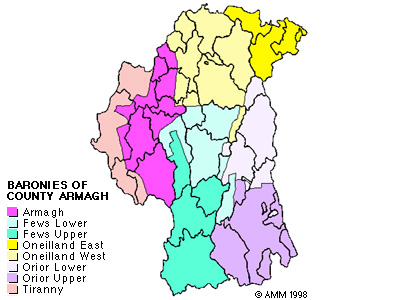
The "Barony" is a now-obsolete administrative unit. It was used from the Middle Ages to the Nineteenth Century to describe the area under the jurisdiction of a baron. There were 58 baronies in the area that comprises the present-day Northern Ireland. The area of Markethill and District occupies an area with the Barony of the Lower Fews and the Barony of Oneilland.
A barony or lordship was held by a lord and, within its territory, all were subject to the jurisdiction of a court-baron held by the lord. As in the English fashion, the areas of baronies granted by James I to the first planters were called 'manors'.
Within his manor, the term 'demesne' or 'demesne land' was used for the lord's chief place of residence (also called his terra dominicales), although, strictly speaking, his demesne included all the land in the manor (except what was in the hands of freeholders). Freeholders held land for ever and, in Swann's 1693 map for Sir Nicolas Acheson of Lower Coolmillish Manor in the Barony of the Lower Fews, Mr Woods land is noted as freehold. The other planters in the area held their land in grant from the lord (Acheson) as 'copyholders' (they held their land by virtue of a document similar to a lease).
The Order of Baronet of Great Britain was a titled order created and instituted by James I on May 22nd, 1611, to raise money for the plantation of Ireland. Etiquette required a baronet to be addressed as "Sir A. B., Bart". The order of Baronet of Ireland was created by James I in 1619. The title was herititary by male heirs. The badge of a baronet is sinister, a hand gules (or 'bloody hand') in a field argent. Note that it was only after 1619 that Archibald Acheson, lord of Coolmillish Manor, was described as "Sir Archibald Acheson" in the Irish State Papers.
In the language of the early Plantation, an Undertaker was one who undertook to perform work for another. It was also the name given about 1610 to members of parliament who put their knowledge in the service of James I. A Serviteur was a male servant, attendant or follower. The first planters were made up of Undertakers (to whom land was granted by the King in return for a fee) and their retinue of settlers who were their Serviteurs. Note that the original serviteurs who went with Acheson were complaining in the 1620s that, in spite of their hard work, they had not been rewarded with their own demesnes, as promised.

The following is a list of the townlands in the area around Markethill grouped under the baronies they come within. The full townland list for each barony is greater.
Barony of Fews Upper: Armaghbrague, Corran, Farranamucklagh, Lislea (Fews Upper), Lisnadill,
Barony of Armagh: Aghavilly, Ballyards, Ballycoffey or Ballyhoy, Ballyheridan, Ballynahone Beg, Baltarran, Cavanacaw, Enagh, Farmacaffly, Kennedies, Killynure, Lisbanoe, Lisdrumard, Lislea (Armagh), Magherarville, Moneypatrick, Moneypatrick, Tirearly.
Barony of Fews Lower: Balleer, Ballybrolly, Ballymacanab, Ballymoran, Ballynagalliagh, Broughan, Cashel, Drumconwell, Drumgaw, Ennislare, Foley, Killycapple, Killyfaddy, Latmacollum, Outlack, Seagahan, Tanderagee, Tullybrone, Tullynagin, Ballindarragh, Ballylane, Ballymacawley, Brackly, Carnavanaghan, Carricklane, Cavanagrow, Clady Beg, Clady More, Damoily, Edenykennedy, Enagh, Glasdrummond, Kilbracks, Kilmachugh, Lisnagat, Seaboughan, Ballyanny, Ballygroobany, Ballynewry, Bryandrum, Cabragh (Fews Lower), Carrowmoney, Coolmillish, Cornacrew, Corry, Crunaght, Drumachee, Drumatee, Drumfergus, Drumlack, Drumman, Drumnagloy, Drumorgan, Drumshallan, Dunesmullan, Garvagh, Gosford Demesne, Hamiltonsbawn, Johnstown, Killyruddan, Lattery, Lurgaboy, Macantrim, Magherydogherty, Mullaghbane, Mullaghbrack, Mullurg, Ratarnet, Rocks, Calone, Derrynaught, Derryraine, Drumbee Beg, Drumbee More, Drumbeecross, Drumennis, Drumsavage, Edenaveys, Edenknappagh, Killeen, lenalea, Crunagh, Derlett, Drumgane, Lisdrumchor Lower, Lisdrumchor Upper, Lurgyross.
Barony of Orior Lower: Derrycughan, Drumalaragh, Maghnavery, Ballenan, Ballydogherty, Ballygorman, Ballyvally, Bolton, Brackagh, Carran, Cornagrally, Corrinare, Corrinure, Creeve, Drumcrow, Drummilt, Drummond, Keady Beg, Keady More, Kilcon, Killycarn Lower, Killycarn Upper, Lisnisk, Mavemacullen, Maytone, Mountnorris, Mullaghmore, Rathcarbry, Rathconvil, Tullyallen, Tullyherron, Acton, Aghantaraghan, Aughlish, Ballyargan, Ballymore, Ballynagreagh, Ballynaleck, Ballyreagh, Ballysheil Beg, Ballysheil More, Brannock, Cargans, Carrickbrack, Clare, Cloghoge, Coolyhill, Corcrum, Corernagh, Corlust, Crew Beg, Crew More, Cullentragh, Demoan, Derryallen, Druminargal, Druminure, Drumnaglontagh, Drumnaleg, Federnagh, Glasdrumman, Lisbane, Lisnagree, Lisnaskea, Lisraw, Mavemacullen, Monclone, Moodoge, Mullaghglass, Mullanary, Mullantur, Shaneglish, Skegatillida, Tannyoky, Terryhoogan, Tullyhugh, Tullylinn, Tullymacann, Tullynacross.
Barony of Orior Upper: Belleek, Carrickananny, Carrickgallogly, Carrowmannan, Creggan Lower, Creggan Upper, Drumharriff, Drumnahoney, Drumnahunshin, Greyhillan, Lisadian, Tullyah, Tullywinny.
Barony of Oneilland West: Cabragh (Oneilland), Dinnahorra, Drumart, Drumnamether, Marlacoo Beg, Marlacoo More, Moyrourkan, Shanecrackan Beg, Shanecrackan More, Tannaghmore, Teemore, Altaturk, Legavilly, Mullaghbane, Mullanasilla, Mullyloughran, Rathdrumgran, Tirnascobe.